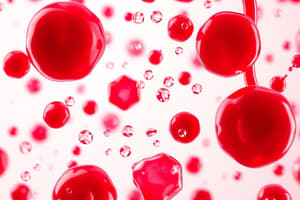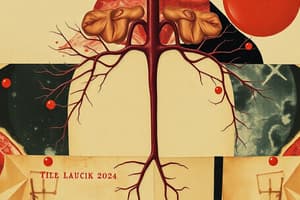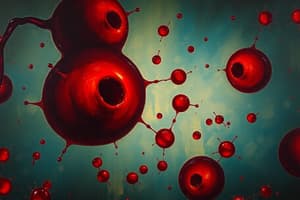Podcast
Questions and Answers
What is the primary function of blood?
What is the primary function of blood?
- To provide structural support to tissues
- To store energy for the body
- To transport oxygen and nutrients to cells (correct)
- To act as a barrier against pathogens
What percentage of blood is plasma?
What percentage of blood is plasma?
- 45%
- 25%
- 55% (correct)
- 75%
Which component of plasma is primarily responsible for blood clotting?
Which component of plasma is primarily responsible for blood clotting?
- Immunoglobulins
- Albumin
- Fibrinogen (correct)
- Glucose
How does plasma help maintain body temperature?
How does plasma help maintain body temperature?
What role do antibodies in plasma play for the body?
What role do antibodies in plasma play for the body?
What is a key characteristic of the water content in plasma?
What is a key characteristic of the water content in plasma?
What aspect of plasma helps regulate pH balance in the body?
What aspect of plasma helps regulate pH balance in the body?
What happens to donated plasma to preserve its quality?
What happens to donated plasma to preserve its quality?
What is the primary function of hemoglobin in red blood cells?
What is the primary function of hemoglobin in red blood cells?
How many polypeptide chains are present in each hemoglobin molecule?
How many polypeptide chains are present in each hemoglobin molecule?
What color is oxyhemoglobin when oxygen is bound to it?
What color is oxyhemoglobin when oxygen is bound to it?
Where is hemoglobin produced in the body?
Where is hemoglobin produced in the body?
What happens to hemoglobin when red blood cells die?
What happens to hemoglobin when red blood cells die?
What does the heme part of hemoglobin contain?
What does the heme part of hemoglobin contain?
What percentage of the weight of hemoglobin does heme account for?
What percentage of the weight of hemoglobin does heme account for?
What is the lifespan of platelets in the bloodstream?
What is the lifespan of platelets in the bloodstream?
What is the primary role of red blood cells in the body?
What is the primary role of red blood cells in the body?
What is the average lifespan of a red blood cell?
What is the average lifespan of a red blood cell?
Which type of white blood cell is primarily responsible for combating bacterial infections?
Which type of white blood cell is primarily responsible for combating bacterial infections?
What percentage of blood volume is typically composed of red blood cells in a healthy individual?
What percentage of blood volume is typically composed of red blood cells in a healthy individual?
Which type of blood cell is predominant in immune responses?
Which type of blood cell is predominant in immune responses?
What is the role of hemoglobin in red blood cells?
What is the role of hemoglobin in red blood cells?
What is the normal range of white blood cells per microliter of blood?
What is the normal range of white blood cells per microliter of blood?
Which type of white blood cell is involved in allergic responses?
Which type of white blood cell is involved in allergic responses?
What is the composition of normal adult hemoglobin?
What is the composition of normal adult hemoglobin?
At what age does the normal hemoglobin range for infants begin to decrease?
At what age does the normal hemoglobin range for infants begin to decrease?
What condition is defined as having lower than a normal number of red blood cells?
What condition is defined as having lower than a normal number of red blood cells?
Which of the following can cause high levels of hemoglobin?
Which of the following can cause high levels of hemoglobin?
What is a potential cause of low hemoglobin levels related to dietary deficiencies?
What is a potential cause of low hemoglobin levels related to dietary deficiencies?
Which group has the lowest normal hemoglobin range?
Which group has the lowest normal hemoglobin range?
What term is used for the disorder that may arise from abnormal hemoglobin structure?
What term is used for the disorder that may arise from abnormal hemoglobin structure?
What is a common consequence of living at high altitudes?
What is a common consequence of living at high altitudes?
What is one of the symptoms of severe anemia?
What is one of the symptoms of severe anemia?
Which type of anemia is associated with insufficient iron in the body?
Which type of anemia is associated with insufficient iron in the body?
What is hemolytic anemia characterized by?
What is hemolytic anemia characterized by?
What condition can cause lifelong medical issues and is inherited?
What condition can cause lifelong medical issues and is inherited?
What is a major symptom of hemophilia?
What is a major symptom of hemophilia?
What can aplastic anemia result from?
What can aplastic anemia result from?
What is one possible cause of acquired hemolytic anemia?
What is one possible cause of acquired hemolytic anemia?
Which anemia type requires regular blood transfusions in severe cases?
Which anemia type requires regular blood transfusions in severe cases?
What is a common symptom of hypocalcemia?
What is a common symptom of hypocalcemia?
Which factor is often associated with causing hypocalcemia?
Which factor is often associated with causing hypocalcemia?
What treatment is commonly recommended for individuals with chronic hypocalcemia?
What treatment is commonly recommended for individuals with chronic hypocalcemia?
What might be a severe consequence of untreated hypocalcemia?
What might be a severe consequence of untreated hypocalcemia?
Which of the following is NOT a recognizable symptom of hypocalcemia?
Which of the following is NOT a recognizable symptom of hypocalcemia?
Flashcards
Blood Composition
Blood Composition
Blood, vital for life, is a fluid connective tissue transporting oxygen, nutrients, and removing waste, regulating body temperature.
Plasma
Plasma
Liquid part of blood, about 55%, mostly water, containing proteins, salts, sugars, fats, hormones, and vitamins crucial for many bodily functions.
Plasma Functions
Plasma Functions
Plasma plays diverse roles including clotting (factors), immunity (antibodies), blood pressure/volume regulation (albumin), pH balance, transporting nutrients and wastes, and maintaining body temperature.
Red Blood Cells
Red Blood Cells
Signup and view all the flashcards
White Blood Cells
White Blood Cells
Signup and view all the flashcards
Platelets
Platelets
Signup and view all the flashcards
Blood Donation
Blood Donation
Signup and view all the flashcards
Blood Donation Plasma Preparation
Blood Donation Plasma Preparation
Signup and view all the flashcards
Red Blood Cells (RBC)
Red Blood Cells (RBC)
Signup and view all the flashcards
Hemoglobin
Hemoglobin
Signup and view all the flashcards
White Blood Cells (WBC)
White Blood Cells (WBC)
Signup and view all the flashcards
Neutrophils
Neutrophils
Signup and view all the flashcards
Platelets
Platelets
Signup and view all the flashcards
RBC Count Range (Female)
RBC Count Range (Female)
Signup and view all the flashcards
Lifespan of RBCs
Lifespan of RBCs
Signup and view all the flashcards
Lifespan of WBCs
Lifespan of WBCs
Signup and view all the flashcards
Platelet Function
Platelet Function
Signup and view all the flashcards
Platelet Count Range
Platelet Count Range
Signup and view all the flashcards
Hemoglobin Function
Hemoglobin Function
Signup and view all the flashcards
Hemoglobin Structure
Hemoglobin Structure
Signup and view all the flashcards
Hemoglobin's Oxygen Binding
Hemoglobin's Oxygen Binding
Signup and view all the flashcards
Hemoglobin Breakdown
Hemoglobin Breakdown
Signup and view all the flashcards
Hemoglobin Location
Hemoglobin Location
Signup and view all the flashcards
Platelet Lifespan
Platelet Lifespan
Signup and view all the flashcards
Hemoglobin Structure
Hemoglobin Structure
Signup and view all the flashcards
Normal Hemoglobin Levels
Normal Hemoglobin Levels
Signup and view all the flashcards
High Hemoglobin
High Hemoglobin
Signup and view all the flashcards
Low Hemoglobin (Anemia)
Low Hemoglobin (Anemia)
Signup and view all the flashcards
Causes of Low Hemoglobin
Causes of Low Hemoglobin
Signup and view all the flashcards
Fetal Hemoglobin
Fetal Hemoglobin
Signup and view all the flashcards
Anemia
Anemia
Signup and view all the flashcards
Hemoglobin Value Units
Hemoglobin Value Units
Signup and view all the flashcards
Anemia
Anemia
Signup and view all the flashcards
Hypocalcemia
Hypocalcemia
Signup and view all the flashcards
Severe Anemia
Severe Anemia
Signup and view all the flashcards
Symptoms of Hypocalcemia
Symptoms of Hypocalcemia
Signup and view all the flashcards
Aplastic Anemia
Aplastic Anemia
Signup and view all the flashcards
Treatment for Hypocalcemia
Treatment for Hypocalcemia
Signup and view all the flashcards
Parathyroid Hormone (PTH)
Parathyroid Hormone (PTH)
Signup and view all the flashcards
Iron-Deficiency Anemia
Iron-Deficiency Anemia
Signup and view all the flashcards
Vitamin D's role in calcium
Vitamin D's role in calcium
Signup and view all the flashcards
Hemolytic Anemia
Hemolytic Anemia
Signup and view all the flashcards
Thalassemia
Thalassemia
Signup and view all the flashcards
Hemophilia
Hemophilia
Signup and view all the flashcards
Symptoms of Anemia
Symptoms of Anemia
Signup and view all the flashcards
Study Notes
Blood Overview
- Blood is a vital component of life, found in any animal with a circulatory system
- Blood is a fluid connective tissue transporting oxygen and nutrients to cells
- Blood carries away carbon dioxide and other waste products
- Blood regulates body temperature
- Blood is a transport liquid, pumped by the heart (or equivalent) to all body parts and returned to the heart
Blood Components
- Blood has four main components: plasma, red blood cells, white blood cells, and platelets
- Approximately 55% of blood is plasma
- Remaining 45% consists of red blood cells, white blood cells and platelets suspended in plasma
Plasma
- Largest component of blood
- Primarily composed of water (92%)
- Contains vital proteins for various functions and substance transport (7%)
- Remaining 1% includes minerals, sugars, fats, hormones, and vitamins
- Plays a crucial role in blood clotting (coagulation) through elements like fibrinogen, thrombin, and factor X
- Supports the immune system (immunity) via antibodies and immunoglobulins
- Maintains blood pressure and volume through albumin
- Balances body temperature, transporting nutrients, electrolytes, hormones, and removing waste to liver, lungs, kidneys, or skin
Red Blood Cells (RBCs)
- Also called erythrocytes
- Begin as immature cells in bone marrow
- Mature over approximately 7 days
- Each RBC lives for roughly 120 days
- Human body produces around 2 million RBCs every second
- Disc-shaped with a flat center, abundant (40-45% of blood volume)
- Lack a nucleus, allowing for flexible shape for movement through blood vessels
- Contain hemoglobin, giving blood its red color and transporting oxygen throughout the body
- Normal RBC count (reference range) varies by gender and age
White Blood Cells (WBCs)
- Also called leukocytes
- Essential component of the immune system
- Produced and stored (80-90%) in bone marrow stem cells
- Lifespan is approximately 12-20 days
- Normal range is 4000-11000 cells per microliter of blood
- 1% of blood volume is WBCs
- Fight invaders by producing antibody proteins
- Classified into granulocytes and agranulocytes
Types of White Blood Cells
- Neutrophils: Protect against infections (bacteria, fungi, and foreign debris)
- Lymphocytes: Combat viral infections (T cells, natural killer cells, and B cells producing antibodies)
- Eosinophils: Destroy parasites and cancer cells
- Basophils: Involved in allergic responses (coughing, sneezing, runny nose)
- Monocytes: Clean up damaged cells
Platelets
- Also called thrombocytes
- Fragments of megakaryocytes (larger cells made in bone marrow)
- Crucial for wound healing
- Platelet count ranges from 150,000 to 400,000 cells per microliter of blood
- Life span is about 10 days
- Prevent and control bleeding by forming clots at injured blood vessel lining, stopping blood leaks
Hemoglobin
- Protein molecule in red blood cells
- Transports oxygen from lungs to body tissues, and carbon dioxide to the lungs
- Bonds reversibly with oxygen (bright red when oxygenated and purplish blue when not)
- Produced in bone marrow, circulated with red blood cells, and destroyed along with red blood cells
- Iron is salvaged and transported back to bone marrow
- Excreted through the intestines after breakdown by spleen
Hemoglobin Structure
- A protein consisting of four polypeptide chains (2 alpha and 2 beta chains), each with a heme group
- Heme contains iron, allowing oxygen binding
- Hemoglobin structure varies during different developmental stages (normal adult vs. fetus/infant)
Normal Hemoglobin Values
- Varies based on age and gender
- Ranges provided for newborns, children, adult males, and adult females
High Hemoglobin Levels
- Higher than normal range seen in people in high altitudes and smokers
- Can result from lung disease, tumors, and erythropoietin abuse
Low Hemoglobin Levels (Anemia)
- Lower than normal range
- Common causes include blood loss, nutrient deficiencies (iron, vitamin B12, and folate), bone marrow problems, kidney failure, and abnormal hemoglobin structure
Blood Diseases Overview
- Anemia: Condition caused by low red blood cell count or malfunctioning red blood cells; inherited or acquired
- Symptoms of Anemia: Fatigue, chest pain, dizziness, headache, pallor, shortness of breath, brittle nails, and weakness
- Types of Anemia
- Aplastic: Bone marrow stops producing red blood cells
- Iron-deficiency: Lack of iron in the body (most common)
- Thalassemia: Inherited disorder resulting in lower than normal hemoglobin levels
- Hemolytic: Red blood cells destroyed faster than created; inherited or acquired
- Hemophilia: Rare disorder with inadequate blood-clotting proteins; symptoms like nosebleeds, excessive bruising
Hypocalcemia
- Condition where calcium levels in the blood are too low
- Often caused by abnormal levels of parathyroid hormone (PTH) or vitamin D
- Can be mild or severe, temporary or chronic
- Symptoms: Tingling in lips, tongue, fingers, muscle aches, muscle spasms (tetany), seizures, abnormal heart rhythms, and heart failure
Medications and Treatments for Hypocalcemia
- Oral calcium pills to increase calcium levels
- Vitamin D supplements to help body absorb calcium
Studying That Suits You
Use AI to generate personalized quizzes and flashcards to suit your learning preferences.




